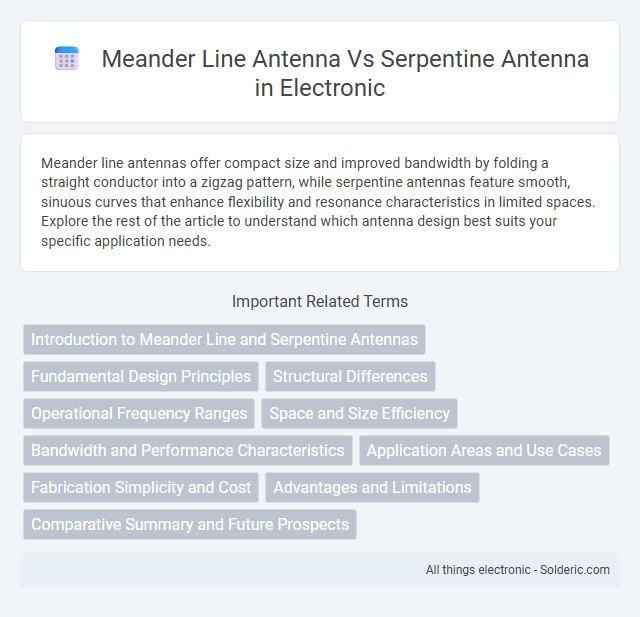Meander line antennas offer compact size and improved bandwidth by folding a straight conductor into a zigzag pattern, while serpentine antennas feature smooth, sinuous curves that enhance flexibility and resonance characteristics in limited spaces. Explore the rest of the article to understand which antenna design best suits your specific application needs.
Comparison Table
| Feature | Meander Line Antenna | Serpentine Antenna |
|---|---|---|
| Design | Series of folded lines creating a compact, zigzag pattern | Multiple S-shaped curves forming a compact winding structure |
| Size Reduction | Effective for moderate size reduction | Provides greater miniaturization than meander line |
| Bandwidth | Narrow to moderate bandwidth | Generally narrow bandwidth due to complex structure |
| Frequency Range | Common in VHF to UHF bands | Used in UHF and microwave frequency bands |
| Radiation Efficiency | Moderate efficiency, reduced by line losses | Lower efficiency due to increased losses in bends |
| Applications | Compact wireless devices, RFID, GPS | Wearable devices, compact microwave circuits |
| Impedance Matching | Relatively simpler, tunable by line length | More complex matching required due to geometry |
Introduction to Meander Line and Serpentine Antennas
Meander line antennas feature a zigzag pattern that effectively reduces the antenna's physical length while maintaining its electrical length, making them suitable for compact wireless devices. Serpentine antennas extend the concept by incorporating multiple curved segments, increasing the current path to enhance bandwidth and improve impedance matching. Both designs optimize spatial efficiency and performance in limited spaces but differ in complexity and application-specific benefits.
Fundamental Design Principles
Meander line antennas utilize a folded wire pattern to effectively reduce antenna size while maintaining resonant frequency, employing inductive and capacitive effects to lengthen the current path. Serpentine antennas consist of a series of parallel conductors connected in a zigzag pattern, enabling enhanced bandwidth and improved impedance matching through distributed inductance and capacitance. Both designs optimize space and performance, but your choice depends on specific application requirements such as size constraints and frequency range.
Structural Differences
Meander line antennas feature a continuous zigzag pattern that lengthens the effective electrical path while maintaining a compact physical size, whereas serpentine antennas consist of a series of parallel conductive strips connected in a snake-like shape to achieve similar miniaturization. The structural complexity of serpentine antennas often allows for more precise control of impedance and frequency response compared to the simpler meander line design. Your choice between these antennas impacts the antenna's size, bandwidth, and tuning flexibility based on the fundamental physical layout of each structure.
Operational Frequency Ranges
Meander line antennas typically operate efficiently within VHF to UHF frequency ranges, offering compact size for limited space applications. Serpentine antennas extend functionality by enabling operation at lower frequencies through increased effective electrical length within a limited physical footprint. Understanding Your required operational frequency range will determine whether the meander line or serpentine antenna best suits Your antenna design needs.
Space and Size Efficiency
Meander line antennas offer significant space efficiency by folding a long conductor into a compact layout, reducing the overall antenna size without compromising performance. Serpentine antennas, with their repeated bends and turns, also provide size reduction but tend to occupy more area compared to meander line designs due to wider spacing requirements. Meander line antennas are preferred when maximizing space and minimizing footprint is critical in compact wireless devices.
Bandwidth and Performance Characteristics
Meander line antennas offer narrower bandwidth but compact size, making them suitable for applications where space is limited and consistent performance over a specific frequency range is required. Serpentine antennas provide broader bandwidth and better impedance matching, enhancing overall performance across multiple frequency bands. Your choice depends on prioritizing compactness with moderate bandwidth or wider frequency coverage with improved efficiency.
Application Areas and Use Cases
Meander line antennas are widely used in compact wireless devices such as RFID tags, Bluetooth modules, and IoT sensors due to their space-saving design and efficient performance at lower frequencies. Serpentine antennas, characterized by their elongated, zigzag structure, excel in applications requiring enhanced bandwidth and flexible frequency tuning, making them suitable for advanced radar systems and flexible wearable electronics. Your choice between these two antennas should consider the specific application requirements, particularly space constraints and frequency range demands.
Fabrication Simplicity and Cost
Meander line antennas offer simpler fabrication processes and lower manufacturing costs due to their straightforward linear pattern, making them ideal for mass production with standard PCB techniques. In contrast, serpentine antennas require more complex etching and precise bending, increasing production time and expenses. Your choice between these antennas should consider budget constraints and the ease of integration into your device's design.
Advantages and Limitations
Meander line antennas offer a compact design with enhanced electrical length, making them ideal for space-constrained applications, but they may suffer from reduced bandwidth and efficiency. Serpentine antennas provide improved impedance matching and increased bandwidth due to their intricate folded structure, yet their complexity can lead to higher fabrication costs and increased losses. Both antenna types balance size reduction with performance trade-offs, where meander lines prioritize miniaturization and serpentines emphasize bandwidth enhancement.
Comparative Summary and Future Prospects
Meander line antennas offer compact size and improved impedance matching, making them ideal for wearable and IoT devices, while serpentine antennas provide greater bandwidth and enhanced polarization diversity, suitable for advanced communication systems. Your choice depends on priorities like size constraints or signal performance in specific applications. Future trends suggest integrating metamaterials and adaptive tuning to further enhance efficiency and miniaturization for both antenna types.
meander line antenna vs serpentine antenna Infographic

 solderic.com
solderic.com